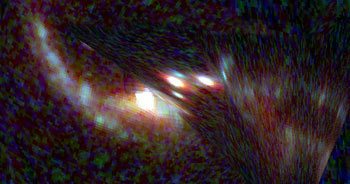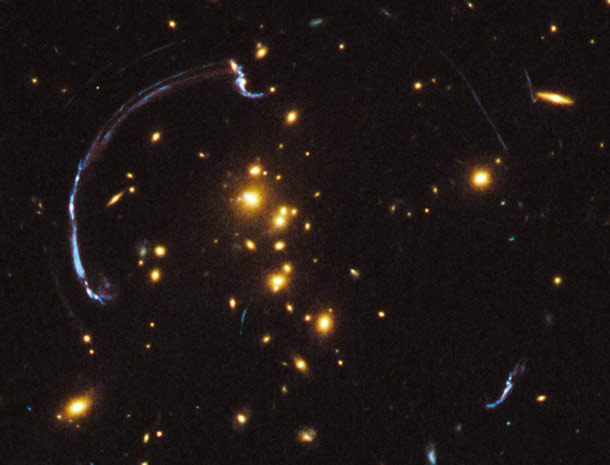Create a free profile to get unlimited access to exclusive videos, sweepstakes, and more!
Funhouse galaxy

Sometimes, I like to think of a photon of light as a car on a road. As the road dips and curves, a car has to follow that path, dipping and curving as well. It might be weird to think of space as curving, but it does. Gravity from massive objects warps space, and a beam of light moving through that curved space curves along with it.
This is the principle behind what's called gravitational lensing. A beam of light passing by an object -- a big galaxy, say, or a cluster of galaxies -- bends one way. A beam headed in a slightly different direction bends a slightly different way. This can really mess with what we see... which I can prove! Check this out: a Hubble image of the galaxy RCSGA 032727-13260.
What a mess! All those arcs and blue smudges are images of that one galaxy. The light from that galaxy traveled nearly 10 billion light years to get here! But when it was halfway here, that light passed by the big cluster of galaxies -- the red fuzzballs -- in the middle of the image. As it did, the curvature of space distorted and warped the light from the galaxy, and by the time it reached us here at Earth the image looks like this. The outstretched, smeared-out arc is amazing; I've never seen one that long and well-defined before.
 Not only that, but the image gets broken up into several separate images. There are no fewer than four different repetitions of the background galaxy in the big image. To show that, I put three of them together here. It's goofed up, to be sure, but you can kinda sorta see they are the same galaxy, flipped over and/or smudged out.
Not only that, but the image gets broken up into several separate images. There are no fewer than four different repetitions of the background galaxy in the big image. To show that, I put three of them together here. It's goofed up, to be sure, but you can kinda sorta see they are the same galaxy, flipped over and/or smudged out.
The cool thing about this is we can learn about the more distant galaxy by examining these images. While you might think this would be a pain for astronomers to sort out what's going on -- and it is -- nature provides a little help: lenses like this can magnify and make the galaxy look a lot brighter than it normally would, so we actually can see galaxies farther away than we normally could. And c'mon, ten billion light years is a long, long way off!
 So what happens when astronomers disentangle all that weird smeary stuff and reconstruct what the galaxy looks like? Well, here it is. It's still a mess, but you can see it's a wide-armed spiral, and it's very blue. That means there's lots of star formation going on -- young massive stars are blue, and very bright -- which isn't too surprising; young galaxies are known to be stellar nurseries. But this one has very bright knots of star birth, even brighter than our own Milky Way. That gives astronomers precious insight into conditions in the distant Universe. And since it took 10 billion years for that light to get here, that means we're seeing the Universe when it was young! So we're seeing this galaxy as it appeared just about 3 or so billion years after the Big Bang.
So what happens when astronomers disentangle all that weird smeary stuff and reconstruct what the galaxy looks like? Well, here it is. It's still a mess, but you can see it's a wide-armed spiral, and it's very blue. That means there's lots of star formation going on -- young massive stars are blue, and very bright -- which isn't too surprising; young galaxies are known to be stellar nurseries. But this one has very bright knots of star birth, even brighter than our own Milky Way. That gives astronomers precious insight into conditions in the distant Universe. And since it took 10 billion years for that light to get here, that means we're seeing the Universe when it was young! So we're seeing this galaxy as it appeared just about 3 or so billion years after the Big Bang.
All that, because space is warped. Think about that next time you see yourself in a funhouse mirror.
Image credit: NASA, ESA, J. Rigby (NASA Goddard Space Flight Center), K. Sharon (Kavli Institute for Cosmological Physics, University of Chicago), and M. Gladders and E. Wuyts (University of Chicago)
Related posts:
- Galaxies swarm and light bends under dark matterâs sway
- The galaxy may swarm with billions of wandering planets
- Obese, gluttonous, and cannibalistic is no way to go through life, son
- Hubble spots 67 gravitational lenses



























